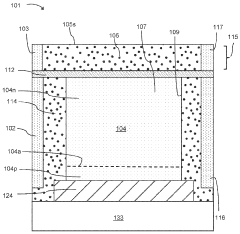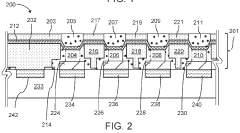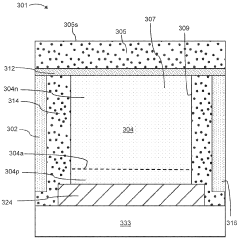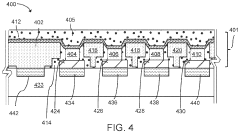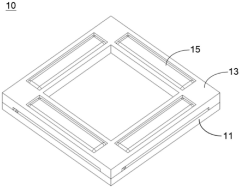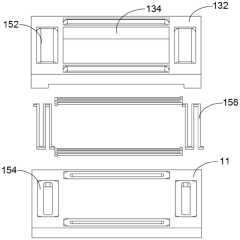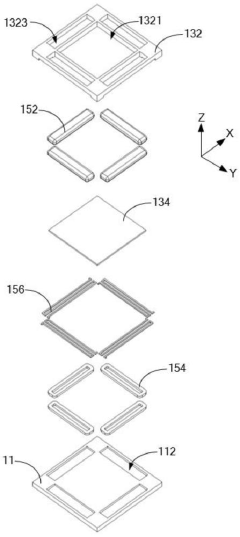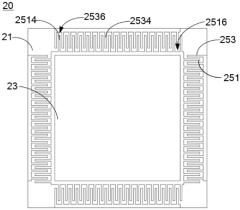The Environmental Impact of ULED Manufacturing
JUN 20, 20259 MIN READ
Generate Your Research Report Instantly with AI Agent
Patsnap Eureka helps you evaluate technical feasibility & market potential.
ULED Tech Evolution
The evolution of Ultra Light Emitting Diode (ULED) technology has been marked by significant advancements in efficiency, brightness, and environmental sustainability. Initially developed as an improvement over traditional LED technology, ULED has undergone several iterations to reach its current state.
In the early stages of ULED development, researchers focused on enhancing the light output and energy efficiency of LEDs. This led to the introduction of quantum dot technology, which allowed for more precise control of light wavelengths and improved color accuracy. The integration of quantum dots into LED structures marked a crucial milestone in ULED evolution, enabling the production of displays with higher contrast ratios and wider color gamuts.
As ULED technology progressed, manufacturers turned their attention to reducing the environmental impact of production processes. This shift was driven by increasing awareness of the ecological footprint associated with electronic manufacturing. Early ULED production methods relied heavily on rare earth elements and toxic materials, which posed significant environmental challenges.
The next phase of ULED evolution saw the introduction of more sustainable manufacturing techniques. Researchers developed new methods for synthesizing quantum dots using less harmful materials and more energy-efficient processes. This included the exploration of cadmium-free quantum dots and the use of solution-based manufacturing methods that reduced waste and energy consumption.
Concurrently, advancements in thin-film deposition techniques allowed for the creation of ULEDs with improved light extraction efficiency. This not only enhanced the overall performance of ULED displays but also reduced the amount of energy required during operation, further minimizing their environmental impact.
Recent years have witnessed a focus on circular economy principles in ULED manufacturing. This approach emphasizes the importance of recyclability and the use of renewable materials in production. Manufacturers have begun implementing take-back programs and exploring ways to recover and reuse valuable materials from end-of-life ULED products.
The latest developments in ULED technology are centered around the concept of "green" quantum dots. These are engineered to be more environmentally friendly throughout their lifecycle, from production to disposal. Researchers are investigating bio-based materials and non-toxic alternatives that can deliver comparable or superior performance to traditional quantum dots while significantly reducing environmental harm.
As ULED technology continues to evolve, there is an increasing emphasis on holistic sustainability. This includes not only the environmental impact of manufacturing but also the long-term energy efficiency of ULED products in use. Innovations in power management and heat dissipation are enabling ULEDs to operate at lower temperatures, extending their lifespan and reducing the frequency of replacement, which in turn lessens electronic waste.
In the early stages of ULED development, researchers focused on enhancing the light output and energy efficiency of LEDs. This led to the introduction of quantum dot technology, which allowed for more precise control of light wavelengths and improved color accuracy. The integration of quantum dots into LED structures marked a crucial milestone in ULED evolution, enabling the production of displays with higher contrast ratios and wider color gamuts.
As ULED technology progressed, manufacturers turned their attention to reducing the environmental impact of production processes. This shift was driven by increasing awareness of the ecological footprint associated with electronic manufacturing. Early ULED production methods relied heavily on rare earth elements and toxic materials, which posed significant environmental challenges.
The next phase of ULED evolution saw the introduction of more sustainable manufacturing techniques. Researchers developed new methods for synthesizing quantum dots using less harmful materials and more energy-efficient processes. This included the exploration of cadmium-free quantum dots and the use of solution-based manufacturing methods that reduced waste and energy consumption.
Concurrently, advancements in thin-film deposition techniques allowed for the creation of ULEDs with improved light extraction efficiency. This not only enhanced the overall performance of ULED displays but also reduced the amount of energy required during operation, further minimizing their environmental impact.
Recent years have witnessed a focus on circular economy principles in ULED manufacturing. This approach emphasizes the importance of recyclability and the use of renewable materials in production. Manufacturers have begun implementing take-back programs and exploring ways to recover and reuse valuable materials from end-of-life ULED products.
The latest developments in ULED technology are centered around the concept of "green" quantum dots. These are engineered to be more environmentally friendly throughout their lifecycle, from production to disposal. Researchers are investigating bio-based materials and non-toxic alternatives that can deliver comparable or superior performance to traditional quantum dots while significantly reducing environmental harm.
As ULED technology continues to evolve, there is an increasing emphasis on holistic sustainability. This includes not only the environmental impact of manufacturing but also the long-term energy efficiency of ULED products in use. Innovations in power management and heat dissipation are enabling ULEDs to operate at lower temperatures, extending their lifespan and reducing the frequency of replacement, which in turn lessens electronic waste.
Market Demand Analysis
The market demand for ULED (Ultra Light Emitting Diode) technology has been steadily growing, driven by the increasing consumer preference for high-quality displays in various electronic devices. As consumers become more environmentally conscious, there is a rising demand for eco-friendly manufacturing processes in the electronics industry, including ULED production.
The global ULED market is expected to experience significant growth in the coming years, primarily due to the technology's superior energy efficiency and picture quality compared to traditional LED displays. This growth is particularly evident in the television, smartphone, and automotive display sectors, where ULED technology offers advantages in terms of brightness, contrast, and color accuracy.
In the television market, ULED displays are gaining traction as consumers seek more immersive viewing experiences. The demand for large-screen, high-resolution televisions with enhanced picture quality is driving the adoption of ULED technology. Similarly, in the smartphone industry, manufacturers are increasingly incorporating ULED displays to differentiate their products and meet consumer expectations for vibrant, energy-efficient screens.
The automotive sector represents another significant market for ULED technology, with a growing demand for advanced infotainment systems and digital dashboards. ULED displays offer improved visibility and durability in automotive applications, making them an attractive option for vehicle manufacturers.
However, the environmental impact of ULED manufacturing has become a critical concern for both consumers and industry stakeholders. There is a growing demand for sustainable production methods that minimize energy consumption, reduce waste, and limit the use of hazardous materials. This shift in consumer preferences is pushing manufacturers to invest in cleaner production technologies and adopt more environmentally friendly practices throughout the ULED manufacturing process.
The market is also witnessing increased demand for ULED products with longer lifespans and improved recyclability. Consumers are becoming more aware of the environmental implications of electronic waste and are seeking products that offer both high performance and sustainability. This trend is encouraging manufacturers to focus on developing ULED technologies that not only deliver superior display quality but also address end-of-life considerations.
As environmental regulations become more stringent globally, there is a growing market for ULED manufacturing solutions that comply with these standards. Companies that can demonstrate their commitment to sustainable production practices are likely to gain a competitive edge in the market, as both consumers and corporate buyers increasingly prioritize environmental considerations in their purchasing decisions.
The global ULED market is expected to experience significant growth in the coming years, primarily due to the technology's superior energy efficiency and picture quality compared to traditional LED displays. This growth is particularly evident in the television, smartphone, and automotive display sectors, where ULED technology offers advantages in terms of brightness, contrast, and color accuracy.
In the television market, ULED displays are gaining traction as consumers seek more immersive viewing experiences. The demand for large-screen, high-resolution televisions with enhanced picture quality is driving the adoption of ULED technology. Similarly, in the smartphone industry, manufacturers are increasingly incorporating ULED displays to differentiate their products and meet consumer expectations for vibrant, energy-efficient screens.
The automotive sector represents another significant market for ULED technology, with a growing demand for advanced infotainment systems and digital dashboards. ULED displays offer improved visibility and durability in automotive applications, making them an attractive option for vehicle manufacturers.
However, the environmental impact of ULED manufacturing has become a critical concern for both consumers and industry stakeholders. There is a growing demand for sustainable production methods that minimize energy consumption, reduce waste, and limit the use of hazardous materials. This shift in consumer preferences is pushing manufacturers to invest in cleaner production technologies and adopt more environmentally friendly practices throughout the ULED manufacturing process.
The market is also witnessing increased demand for ULED products with longer lifespans and improved recyclability. Consumers are becoming more aware of the environmental implications of electronic waste and are seeking products that offer both high performance and sustainability. This trend is encouraging manufacturers to focus on developing ULED technologies that not only deliver superior display quality but also address end-of-life considerations.
As environmental regulations become more stringent globally, there is a growing market for ULED manufacturing solutions that comply with these standards. Companies that can demonstrate their commitment to sustainable production practices are likely to gain a competitive edge in the market, as both consumers and corporate buyers increasingly prioritize environmental considerations in their purchasing decisions.
Eco-Challenges in ULED
The manufacturing process of Ultra Light Emitting Diodes (ULEDs) presents several significant environmental challenges that demand careful consideration and innovative solutions. One of the primary concerns is the extensive use of rare earth elements, particularly indium and gallium, in ULED production. The extraction and processing of these materials often involve environmentally damaging mining practices, leading to habitat destruction, soil erosion, and water pollution in mining regions.
Energy consumption during ULED manufacturing is another critical eco-challenge. The production process requires high-temperature environments and precision equipment, resulting in substantial energy usage and associated carbon emissions. This energy-intensive nature of ULED manufacturing contributes to the overall carbon footprint of the technology, potentially offsetting some of the energy-saving benefits ULEDs offer during their operational lifetime.
Chemical waste management poses a significant environmental risk in ULED production. The manufacturing process involves various hazardous chemicals, including acids, solvents, and heavy metals. Improper handling or disposal of these substances can lead to soil and water contamination, affecting local ecosystems and potentially harming human health. Developing effective waste treatment and recycling protocols is crucial to mitigate these risks.
Water usage is another environmental concern in ULED manufacturing. The production process requires large volumes of ultra-pure water for cleaning and processing components. This not only strains local water resources but also generates wastewater that must be carefully treated before release to prevent environmental contamination.
The issue of electronic waste (e-waste) is particularly relevant to ULED technology. As ULEDs become more prevalent in consumer electronics and lighting applications, the disposal of end-of-life products becomes a growing environmental challenge. The complex composition of ULEDs, including various metals and compounds, makes recycling difficult and potentially hazardous if not properly managed.
Packaging materials used in ULED products also contribute to environmental concerns. Many ULED applications require specialized packaging to protect the delicate components, often involving plastics and other non-biodegradable materials. The accumulation of these packaging materials in landfills or their improper disposal can lead to long-term environmental degradation.
Addressing these eco-challenges requires a multifaceted approach, including research into alternative materials, development of more energy-efficient manufacturing processes, implementation of stringent waste management protocols, and design for recyclability. The ULED industry must prioritize sustainability throughout the product lifecycle to minimize its environmental impact and ensure the technology's long-term viability in an increasingly eco-conscious market.
Energy consumption during ULED manufacturing is another critical eco-challenge. The production process requires high-temperature environments and precision equipment, resulting in substantial energy usage and associated carbon emissions. This energy-intensive nature of ULED manufacturing contributes to the overall carbon footprint of the technology, potentially offsetting some of the energy-saving benefits ULEDs offer during their operational lifetime.
Chemical waste management poses a significant environmental risk in ULED production. The manufacturing process involves various hazardous chemicals, including acids, solvents, and heavy metals. Improper handling or disposal of these substances can lead to soil and water contamination, affecting local ecosystems and potentially harming human health. Developing effective waste treatment and recycling protocols is crucial to mitigate these risks.
Water usage is another environmental concern in ULED manufacturing. The production process requires large volumes of ultra-pure water for cleaning and processing components. This not only strains local water resources but also generates wastewater that must be carefully treated before release to prevent environmental contamination.
The issue of electronic waste (e-waste) is particularly relevant to ULED technology. As ULEDs become more prevalent in consumer electronics and lighting applications, the disposal of end-of-life products becomes a growing environmental challenge. The complex composition of ULEDs, including various metals and compounds, makes recycling difficult and potentially hazardous if not properly managed.
Packaging materials used in ULED products also contribute to environmental concerns. Many ULED applications require specialized packaging to protect the delicate components, often involving plastics and other non-biodegradable materials. The accumulation of these packaging materials in landfills or their improper disposal can lead to long-term environmental degradation.
Addressing these eco-challenges requires a multifaceted approach, including research into alternative materials, development of more energy-efficient manufacturing processes, implementation of stringent waste management protocols, and design for recyclability. The ULED industry must prioritize sustainability throughout the product lifecycle to minimize its environmental impact and ensure the technology's long-term viability in an increasingly eco-conscious market.
Green ULED Solutions
01 Energy efficiency and reduced power consumption
ULEDs offer significant improvements in energy efficiency compared to traditional lighting technologies. Their ultra-low power consumption contributes to reduced energy demand and lower greenhouse gas emissions associated with electricity generation. This efficiency can lead to substantial environmental benefits when implemented on a large scale.- Energy efficiency and reduced power consumption: ULEDs offer significant improvements in energy efficiency compared to traditional lighting technologies. Their ultra-low power consumption contributes to reduced energy demand and lower greenhouse gas emissions associated with electricity generation. This efficiency can lead to substantial energy savings in various applications, from consumer electronics to large-scale lighting installations.
- Reduced material usage and miniaturization: The ultra-small size of ULEDs allows for miniaturization of devices and reduced material usage in manufacturing. This can lead to less resource extraction and processing, potentially lowering the overall environmental footprint of products incorporating ULED technology. The compact nature of ULEDs also enables more efficient packaging and transportation, further reducing environmental impact.
- Longer lifespan and reduced waste: ULEDs typically have a longer operational lifespan compared to conventional lighting technologies. This extended durability results in less frequent replacement and disposal, leading to a reduction in electronic waste. The decreased need for replacement also means fewer resources are required for manufacturing and distributing new units over time.
- Potential for hazardous material reduction: Unlike some other lighting technologies, ULEDs can be designed to minimize or eliminate the use of hazardous materials such as mercury. This reduction in harmful substances can lead to safer disposal processes and less environmental contamination. However, proper recycling and disposal methods for ULED components are still crucial to maximize their environmental benefits.
- Application in energy-efficient displays and lighting systems: ULEDs are increasingly used in energy-efficient displays and lighting systems, contributing to overall energy savings in various sectors. Their application in smart lighting systems, automotive displays, and consumer electronics can lead to significant reductions in power consumption on a large scale. This widespread adoption of ULED technology has the potential to contribute to global energy conservation efforts.
02 Reduced material usage and waste
The compact size and advanced manufacturing processes of ULEDs result in reduced material usage compared to conventional LEDs. This leads to less waste generation during production and at the end of the product lifecycle. Additionally, the longer lifespan of ULEDs contributes to a reduction in electronic waste over time.Expand Specific Solutions03 Improved heat dissipation and thermal management
ULEDs incorporate advanced thermal management techniques, resulting in improved heat dissipation. This enhanced thermal performance leads to increased efficiency and longer lifespan, reducing the need for frequent replacements and associated environmental impacts of manufacturing and disposal.Expand Specific Solutions04 Integration with smart lighting systems
ULEDs can be easily integrated into smart lighting systems, allowing for precise control and optimization of lighting conditions. This integration enables energy-saving features such as occupancy sensing and daylight harvesting, further reducing environmental impact through decreased energy consumption.Expand Specific Solutions05 Potential for eco-friendly manufacturing processes
Research into ULED manufacturing processes focuses on developing more environmentally friendly methods. This includes the use of less harmful materials, reduction of hazardous substances, and exploration of recycling techniques for ULED components. These advancements aim to minimize the environmental footprint of ULED production and disposal.Expand Specific Solutions
Key ULED Manufacturers
The ULED manufacturing industry is in a growth phase, with increasing market size driven by demand for high-performance displays. The technology is maturing rapidly, with major players like Samsung Electronics, BOE Technology Group, and Corning leading innovation. Environmental concerns are becoming central to the industry's development, prompting companies such as Industrial Technology Research Institute and Evonik Operations to focus on sustainable manufacturing processes. The competitive landscape is diverse, including established electronics giants, specialized optoelectronics firms like Lumileds and Signify Holding, and research institutions like Boston University. As the industry evolves, there's a growing emphasis on balancing technological advancement with environmental responsibility, influencing both product development and manufacturing strategies across the sector.
Samsung Electronics Co., Ltd.
Technical Solution: Samsung has developed eco-friendly ULED manufacturing processes that significantly reduce energy consumption and harmful emissions. Their approach involves using advanced materials and optimized production techniques to minimize waste and maximize resource efficiency. They have implemented a closed-loop recycling system for rare earth elements used in ULED production, reducing the need for new raw materials extraction. Additionally, Samsung has invested in water-saving technologies and renewable energy sources to power their ULED manufacturing facilities, further reducing the environmental impact.
Strengths: Advanced eco-friendly technologies, efficient resource management, and commitment to sustainability. Weaknesses: Potentially higher initial production costs and the need for continuous innovation to maintain environmental advantages.
Samsung Display Co., Ltd.
Technical Solution: Samsung Display focuses on developing ULED displays with improved energy efficiency and longer lifespans, reducing the overall environmental impact throughout the product lifecycle. They have implemented a green chemistry approach in their manufacturing process, replacing harmful chemicals with more environmentally friendly alternatives. The company has also developed innovative recycling techniques for ULED panels, allowing for the recovery of valuable materials and reducing e-waste. Their manufacturing facilities utilize smart factory systems to optimize energy usage and minimize waste production.
Strengths: Lifecycle-focused approach, innovative recycling techniques, and smart manufacturing processes. Weaknesses: Potential challenges in scaling up eco-friendly production methods and balancing environmental goals with market demands.
Eco-Innovations ULED
Optical layer for pixels of micro-light emitting diode (LED) devices
PatentWO2024129339A1
Innovation
- An optical layer comprising a dielectric material with reflective sidewalls is introduced on the emitting surface of microLED pixels, functioning as a lens or anti-reflective coating to enhance light directionality and extraction efficiency, while also eliminating cross-talk and maximizing brightness.
ULED packaging structure and imaging device
PatentPendingCN116741909A
Innovation
- By introducing a drive reset component into the uLED packaging structure, the drive frame moves in the second direction relative to the substrate to provide a reset force, using the persistence of vision of the human eye to reduce the impact of unlit uLEDs, stabilize imaging quality, and achieve a compact structure. change.
Environmental Policies
Environmental policies play a crucial role in shaping the landscape of ULED manufacturing and its environmental impact. Governments worldwide have implemented various regulations and guidelines to address the potential environmental concerns associated with this emerging technology.
One of the primary focuses of environmental policies in ULED manufacturing is the reduction of hazardous substances. Many countries have adopted regulations similar to the European Union's Restriction of Hazardous Substances (RoHS) directive, which limits the use of certain harmful materials in electronic products. These policies have prompted ULED manufacturers to develop alternative materials and processes that are less environmentally damaging.
Energy efficiency standards have also been established to encourage the development of more sustainable ULED products. For instance, the U.S. Environmental Protection Agency's ENERGY STAR program sets strict energy consumption criteria for electronic displays, including those utilizing ULED technology. Such policies drive innovation in power management and overall energy efficiency of ULED devices.
Waste management and recycling policies have been implemented to address the end-of-life concerns of ULED products. The EU's Waste Electrical and Electronic Equipment (WEEE) directive, for example, mandates the proper collection and recycling of electronic waste. Similar regulations in other regions have led to the development of more recyclable ULED components and improved dismantling processes.
Carbon emission reduction targets set by various nations have indirectly influenced ULED manufacturing. These policies have encouraged manufacturers to adopt cleaner production methods and invest in renewable energy sources for their facilities. Some countries have introduced carbon pricing mechanisms, further incentivizing ULED producers to minimize their carbon footprint.
Water conservation policies have also impacted ULED manufacturing processes. Stringent regulations on water usage and wastewater treatment have led to the development of more water-efficient production techniques and advanced water recycling systems in ULED manufacturing plants.
As the ULED industry continues to evolve, environmental policies are expected to become more comprehensive and tailored to address specific challenges posed by this technology. Future policies may focus on promoting circular economy principles in ULED manufacturing, encouraging the use of bio-based materials, and implementing more stringent life-cycle assessment requirements for ULED products.
One of the primary focuses of environmental policies in ULED manufacturing is the reduction of hazardous substances. Many countries have adopted regulations similar to the European Union's Restriction of Hazardous Substances (RoHS) directive, which limits the use of certain harmful materials in electronic products. These policies have prompted ULED manufacturers to develop alternative materials and processes that are less environmentally damaging.
Energy efficiency standards have also been established to encourage the development of more sustainable ULED products. For instance, the U.S. Environmental Protection Agency's ENERGY STAR program sets strict energy consumption criteria for electronic displays, including those utilizing ULED technology. Such policies drive innovation in power management and overall energy efficiency of ULED devices.
Waste management and recycling policies have been implemented to address the end-of-life concerns of ULED products. The EU's Waste Electrical and Electronic Equipment (WEEE) directive, for example, mandates the proper collection and recycling of electronic waste. Similar regulations in other regions have led to the development of more recyclable ULED components and improved dismantling processes.
Carbon emission reduction targets set by various nations have indirectly influenced ULED manufacturing. These policies have encouraged manufacturers to adopt cleaner production methods and invest in renewable energy sources for their facilities. Some countries have introduced carbon pricing mechanisms, further incentivizing ULED producers to minimize their carbon footprint.
Water conservation policies have also impacted ULED manufacturing processes. Stringent regulations on water usage and wastewater treatment have led to the development of more water-efficient production techniques and advanced water recycling systems in ULED manufacturing plants.
As the ULED industry continues to evolve, environmental policies are expected to become more comprehensive and tailored to address specific challenges posed by this technology. Future policies may focus on promoting circular economy principles in ULED manufacturing, encouraging the use of bio-based materials, and implementing more stringent life-cycle assessment requirements for ULED products.
Life Cycle Assessment
Life Cycle Assessment (LCA) is a crucial tool for evaluating the environmental impact of ULED manufacturing. This comprehensive approach examines the entire lifecycle of ULED products, from raw material extraction to disposal, providing valuable insights into their ecological footprint.
The manufacturing phase of ULEDs is particularly energy-intensive, with significant environmental implications. The production of semiconductor materials, such as gallium nitride and indium gallium nitride, requires substantial energy inputs and may involve the use of hazardous chemicals. These processes contribute to greenhouse gas emissions and potential environmental contamination if not properly managed.
During the use phase, ULEDs demonstrate superior energy efficiency compared to traditional lighting technologies. Their long lifespan and low power consumption result in reduced energy demand and associated environmental benefits over time. This efficiency translates to lower carbon emissions and decreased strain on energy resources throughout the product's operational life.
End-of-life considerations for ULEDs present both challenges and opportunities. The complex composition of these devices, including rare earth elements and other valuable materials, necessitates specialized recycling processes. Proper recycling can recover precious resources, reducing the need for virgin material extraction and mitigating environmental impacts associated with mining and processing.
However, the current infrastructure for ULED recycling is limited in many regions, potentially leading to improper disposal and lost resource recovery opportunities. Improving recycling technologies and establishing robust collection systems are critical steps in minimizing the end-of-life environmental impact of ULEDs.
Transportation and packaging also contribute to the overall environmental footprint of ULEDs. The global nature of supply chains means that components and finished products often travel long distances, resulting in transportation-related emissions. Optimizing logistics and adopting more sustainable packaging materials can help reduce these impacts.
Water usage in ULED manufacturing is another important consideration. The production of semiconductor materials and the cleaning processes involved in manufacturing can consume significant amounts of water. Implementing water recycling systems and more efficient cleaning technologies can help mitigate this impact.
In conclusion, a thorough Life Cycle Assessment of ULED manufacturing reveals a complex interplay of environmental impacts across different stages of the product lifecycle. While ULEDs offer significant environmental benefits during their use phase, addressing the challenges in manufacturing and end-of-life management is crucial for maximizing their overall sustainability. Continued research and innovation in production techniques, material selection, and recycling technologies will be key to further reducing the environmental footprint of ULED manufacturing.
The manufacturing phase of ULEDs is particularly energy-intensive, with significant environmental implications. The production of semiconductor materials, such as gallium nitride and indium gallium nitride, requires substantial energy inputs and may involve the use of hazardous chemicals. These processes contribute to greenhouse gas emissions and potential environmental contamination if not properly managed.
During the use phase, ULEDs demonstrate superior energy efficiency compared to traditional lighting technologies. Their long lifespan and low power consumption result in reduced energy demand and associated environmental benefits over time. This efficiency translates to lower carbon emissions and decreased strain on energy resources throughout the product's operational life.
End-of-life considerations for ULEDs present both challenges and opportunities. The complex composition of these devices, including rare earth elements and other valuable materials, necessitates specialized recycling processes. Proper recycling can recover precious resources, reducing the need for virgin material extraction and mitigating environmental impacts associated with mining and processing.
However, the current infrastructure for ULED recycling is limited in many regions, potentially leading to improper disposal and lost resource recovery opportunities. Improving recycling technologies and establishing robust collection systems are critical steps in minimizing the end-of-life environmental impact of ULEDs.
Transportation and packaging also contribute to the overall environmental footprint of ULEDs. The global nature of supply chains means that components and finished products often travel long distances, resulting in transportation-related emissions. Optimizing logistics and adopting more sustainable packaging materials can help reduce these impacts.
Water usage in ULED manufacturing is another important consideration. The production of semiconductor materials and the cleaning processes involved in manufacturing can consume significant amounts of water. Implementing water recycling systems and more efficient cleaning technologies can help mitigate this impact.
In conclusion, a thorough Life Cycle Assessment of ULED manufacturing reveals a complex interplay of environmental impacts across different stages of the product lifecycle. While ULEDs offer significant environmental benefits during their use phase, addressing the challenges in manufacturing and end-of-life management is crucial for maximizing their overall sustainability. Continued research and innovation in production techniques, material selection, and recycling technologies will be key to further reducing the environmental footprint of ULED manufacturing.
Unlock deeper insights with Patsnap Eureka Quick Research — get a full tech report to explore trends and direct your research. Try now!
Generate Your Research Report Instantly with AI Agent
Supercharge your innovation with Patsnap Eureka AI Agent Platform!
